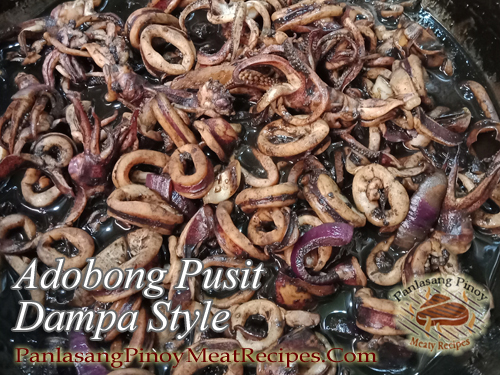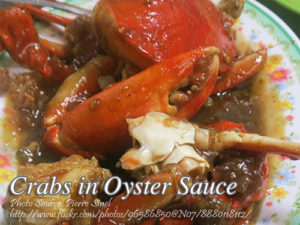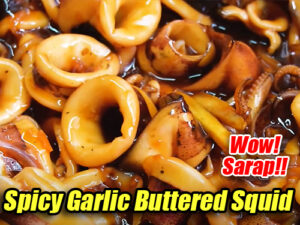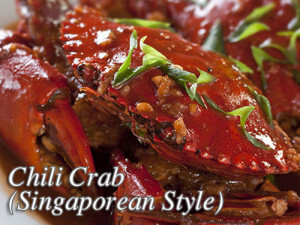This sweet adobong pusit dampa style recipe is absolutely delicious and you will never thought that adobong pusit can be leveled up and made as tasty as this one. I think the secret ingredient here are the combination of garlic, onion, ginger and sugar which I usually used in making stir-fried crabs. If you don’t want to use the ink sac in cooking this dish, you can remove it while cleaning the squid or you can just use few ink sac to make the color of the sauce lighter. Also, if you are wondering why it is named Dampa style its because this squid adobo is also served in Dampa seafood restaurant. But don’t expect that this is the exact recipe because its only a copy cat dish and might vary in taste or the cooking style.
Savor the Flavor: Adobong Pusit Dampa Style
Growing up in a coastal town in Cavite, fresh seafood was always a staple on our dining table. My late Uncle Tony, who used to work as a fisherman, would come home with the freshest catch of the day, and squid was always my favorite. He would tell us, “The simpler the recipe, the better the seafood shines.” That philosophy comes to life in this adobong pusit dampa style, a dish that perfectly balances simplicity and flavor.
A Taste of Nostalgia and Dampa Inspiration
If you’ve ever been to a Dampa seafood restaurant, you know how they elevate humble seafood into dishes bursting with bold, unforgettable flavors. That’s the inspiration behind this adobong pusit dampa style. While it’s not an exact replica of what you’d get at a Dampa, it brings the same essence to your kitchen. The secret? A magical combination of garlic, onion, ginger, and a touch of sugar—ingredients that my mom also swears by when making her stir-fried crabs. There’s something about this blend that adds a layer of sweetness and depth to the dish.
What sets this version apart is the inclusion of the squid’s ink sac. Retaining the ink while cooking gives the dish its signature dark, rich sauce, making it distinctly Filipino. However, if you prefer a lighter-colored sauce, you can remove the ink sac or use only a small amount. It’s entirely up to you. My cousin Linda, who’s always experimenting in the kitchen, swears by leaving just a hint of ink for added umami without making the sauce too dark.
The Perfect Squid: Freshness Matters
When preparing adobong pusit dampa style, the quality of your squid is crucial. Fresh squid should have a clean ocean smell, firm flesh, and clear, shiny skin. My Lola Tess always said, “Fresh squid cooks in minutes; overcooked squid feels like rubber.” That’s a golden rule here. The trick is to cook it just until tender, which takes only about three minutes. Any longer, and you risk losing that tender, juicy texture.
Cleaning the squid may seem daunting, but it’s easier than you think. Start by removing the transparent backbone and the innards while keeping the ink sac intact if you want to use it. Also, don’t forget to remove the beak hidden in the tentacles. A word of caution: handle the eyes carefully to avoid an inky explosion in your kitchen! If you prefer, slice the squid into rings for a more restaurant-style presentation.
Building Layers of Flavor
The beauty of adobong pusit dampa style lies in its simplicity, yet each step is vital in building flavor. Heating oil and sautéing garlic and onion releases a fragrant base, while the addition of ginger and green chili peppers adds warmth and spice. These aromatics are the soul of the dish, creating a base that complements the squid’s natural sweetness.
When adding the squid, soy sauce, and vinegar, resist the urge to stir immediately. This technique ensures the vinegar cooks properly, eliminating any sharp, sour taste and allowing its tangy notes to shine through. My Tita Nena taught me this trick, saying it’s the secret to achieving that signature adobo flavor. Let the liquid come to a boil before briefly cooking the squid, then remove it from the pan to avoid overcooking.
The Sauce That Seals the Deal
Here’s where the magic happens: reducing the sauce. By boiling the liquid until it thickens and slightly caramelizes, you’re concentrating all those delicious flavors. Adding sugar at this stage balances the salty and tangy notes, creating a harmonious sauce that clings beautifully to the squid. Once the sauce reaches the right consistency, return the squid to the pan and give it a final toss. A quick minute is all it needs to soak up the flavors without becoming overcooked.
Serving Suggestions and a Dash of History
Adobong pusit, like most Filipino dishes, is best enjoyed with a steaming plate of white rice. The sauce is so flavorful you’ll want to drizzle it generously over your rice. Garnish with chopped spring onions for a pop of color and freshness. If you’re feeling fancy, pair it with a side of ensaladang talong (eggplant salad) or a simple tomato and salted egg salad for a complete meal.
Did you know that squid ink has been used in cooking for centuries? In Filipino cuisine, it’s not just about the unique color but also the rich umami it brings to the dish. This practice likely originated from a time when nothing was wasted, a philosophy deeply ingrained in Filipino cooking. It’s fascinating how these traditions continue to influence our kitchens today.
A Dish to Bring People Together
For me, adobong pusit dampa style isn’t just a recipe; it’s a connection to my roots and my family’s love for simple, flavorful meals. Whether it’s a casual weekday dinner or a special gathering, this dish always earns a spot on our table. Its bold, comforting flavors remind me of home and the joyful chaos of family meals.
So, the next time you’re craving something new yet familiar, give this recipe a try. It’s a humble dish that packs a punch, proving once again that in Filipino cooking, simplicity is truly the ultimate sophistication.
How to Cook Adobong Pusit Dampa Style
Ingredients
- 1 kilo medium sized fresh squid
- 4 cloves garlic minced
- 1 pc medium sized onion chopped
- 1 pc thumb sized ginger chopped
- 1/4 cup soy sauce
- 1/2 cup vinegar
- 2 pcs green chili peppers siling panigang
- patis to taste
- 1 Tbsp. sugar
- 1 Tbsp. cooking oil
- pepper to taste
- spring onions or kinchay chopped (for garnishing)
Instructions
How to cook Squid Adobo Dampa Style:
- Clean the squid by removing the transparent plastic-like backbone inside the squid. Remove the innards but retain the ink sac. Remove the also the beak in the middle of the tentacles by squeezing the head. Wash in running water and drain.
- Just be careful not the press the eyes of the squid or it will burst. If the squid are large or just prefer to slice it, you can also slice the squid into rings.
- Heat oil in the pan and saute garlic and onion until fragrant. Then add the ginger and green chili peppers and saute for a minute.
- Immediately add the fresh squid, soy sauce and vinegar. Do not stir. Bring to a boil then cook the squid for about 3 minutes without covering the pan.
- Remove the squid from the liquid and set aside. Continue to boil the liquid in the pan and add sugar. Let it boil until the liquid evaporates and slightly thick in consistency.
- Then put back the squid and stir. Let it cook for a minute more while stirring then turn off heat. Serve hot and garnish with chopped spring onions.
Notes
Cooking Tips:
Choose Fresh and Medium-Sized Squid
For the best texture and flavor, always select fresh, medium-sized squid. Smaller squid tend to be too delicate, while larger ones can turn rubbery if not cooked carefully. Check for clear, shiny skin and a clean ocean scent to ensure the freshest quality.Cook Squid Quickly to Avoid Toughness
Squid cooks quickly, so be sure to limit cooking time to just 2-3 minutes initially. Overcooking can make the squid chewy and tough, losing its tender bite. Removing the squid before reducing the sauce also helps maintain its perfect texture.Balance the Sauce for a Perfect Blend
The right mix of vinegar, soy sauce, and sugar is crucial for a balanced sauce. Make sure to let the vinegar boil first without stirring to eliminate its sharpness. Adjust the sweetness by gradually adding sugar to taste, ensuring it complements the savory and tangy notes.





